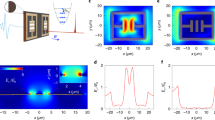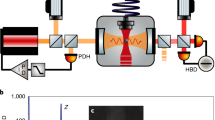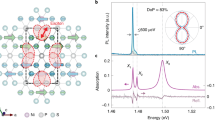Abstract
Hybrid excitations, called polaritons, emerge in systems with strong light–matter coupling. Usually, they dominate the linear and nonlinear optical properties with applications in quantum optics. Here, we show the crucial role of the electronic component of polaritons in the magneto-transport of a cavity-embedded two-dimensional electron gas in the ultrastrong coupling regime. We show that the linear direct-current resistivity is substantially modified by the coupling to the cavity even without external irradiation. Our observations confirm recent predictions of vacuum-induced modification of the resistivity. Furthermore, photo-assisted transport in the presence of a weak irradiation field at sub-terahertz frequencies highlights the different roles of localized and delocalized states.
This is a preview of subscription content, access via your institution
Access options
Access Nature and 54 other Nature Portfolio journals
Get Nature+, our best-value online-access subscription
$29.99 / 30 days
cancel any time
Subscribe to this journal
Receive 12 print issues and online access
$209.00 per year
only $17.42 per issue
Buy this article
- Purchase on Springer Link
- Instant access to full article PDF
Prices may be subject to local taxes which are calculated during checkout




Similar content being viewed by others
Data availability
The datasets generated and analysed during the current study are available from the corresponding authors on reasonable request.
References
Thompson, R., Rempe, G. & Kimble, H. Observation of normal-mode splitting for an atom in an optical cavity. Phys. Rev. Lett. 68, 1132 (1992).
Raimond, J.-M., Brune, M. & Haroche, S. Manipulating quantum entanglement with atoms and photons in a cavity. Rev. Mod. Phys. 73, 565 (2001).
Weisbuch, C., Nishioka, M., Ishikawa, A. & Arakawa, Y. Observation of the coupled exciton-photon mode splitting in a semiconductor quantum microcavity. Phys. Rev. Lett. 69, 3314 (1992).
Dini, D., Köhler, R., Tredicucci, A., Biasiol, G. & Sorba, L. Microcavity polariton splitting of intersubband transitions. Phys. Rev. Lett. 90, 116401 (2003).
Smolka, S. et al. Cavity quantum electrodynamics with many-body states of a two-dimensional electron gas. Science 346, 332–335 (2014).
Ciuti, C., Bastard, G. & Carusotto, I. Quantum vacuum properties of the intersubband cavity polariton field. Phys. Rev. B 72, 115303 (2005).
Anappara, A. A. et al. Signatures of the ultrastrong light–matter coupling regime. Phys. Rev. B 79, 201303 (2009).
Günter, G. et al. Sub-cycle switch-on of ultrastrong light–matter interaction. Nature 458, 178–181 (2009).
Niemczyk, T. et al. Circuit quantum electrodynamics in the ultrastrong-coupling regime. Nat. Phys. 6, 772–776 (2010).
Forn-Daz, P. et al. Observation of the Bloch–Siegert shift in a qubit-oscillator system in the ultrastrong coupling regime. Phys. Rev. Lett. 105, 237001 (2010).
Todorov, Y. et al. Ultrastrong light–matter coupling regime with polariton dots. Phys. Rev. Lett. 105, 196402 (2010).
Jouy, P. et al. Transition from strong to ultrastrong coupling regime in mid-infrared metal–dielectric–metal cavities. Appl. Phys. Lett. 98, 231114 (2011).
Muravev, V., Andreev, I., Kukushkin, I., Schmult, S. & Dietsche, W. Observation of hybrid plasmon-photon modes in microwave transmission of coplanar microresonators. Phys. Rev. B 83, 075309 (2011).
Geiser, M. et al. Ultrastrong coupling regime and plasmon polaritons in parabolic semiconductor quantum wells. Phys. Rev. Lett. 108, 106402 (2012).
Scalari, G. et al. Ultrastrong coupling of the cyclotron transition of a 2d electron gas to a THz metamaterial. Science 335, 1323–1326 (2012).
Muravev, V., Gusikhin, P., Andreev, I. & Kukushkin, I. Ultrastrong coupling of high-frequency two-dimensional cyclotron plasma mode with a cavity photon. Phys. Rev. B 87, 045307 (2013).
Gambino, S. et al. Exploring light–matter interaction phenomena under ultrastrong coupling regime. ACS Photon. 1, 1042–1048 (2014).
Orgiu, E. et al. Conductivity in organic semiconductors hybridized with the vacuum field. Nat. Mater. 14, 1123–1129 (2015).
Zhang, Q. et al. Collective non-perturbative coupling of 2d electrons with high-quality-factor terahertz cavity photons. Nat. Phys. 12, 1005–1011 (2016).
Paravicini-Bagliani, G. L. et al. Gate and magnetic field tunable ultrastrong coupling between a magnetoplasmon and the optical mode of an LC cavity. Phys. Rev. B 95, 205304 (2017).
Todorov, Y. & Sirtori, C. Intersubband polaritons in the electrical dipole gauge. Phys. Rev. B 85, 045304 (2012).
Hagenmüller, D., De Liberato, S. & Ciuti, C. Ultrastrong coupling between a cavity resonator and the cyclotron transition of a two-dimensional electron gas in the case of an integer filling factor. Phys. Rev. B 81, 235303 (2010).
Sidler, M. et al. Fermi polaron-polaritons in charge-tunable atomically thin semiconductors. Nat. Phys. 13, 255–261 (2017).
Ravets, S. et al. Polaron polaritons in the integer and fractional quantum Hall regimes. Phys. Rev. Lett. 120, 057401 (2018).
Samkharadze, N. et al. Strong spin-photon coupling in silicon. Science 359, 1123–1127 (2018).
Li, X. et al. Vacuum Bloch–Siegert shift in Landau polaritons with ultra-high cooperativity. Nat. Photon. 12, 324–329 (2018).
Ménard, J.-M. et al. Revealing the dark side of a bright exciton–polariton condensate. Nat. Commun. 5, 4648 (2014).
Maissen, C. et al. Ultrastrong coupling in the near field of complementary split-ring resonators. Phys. Rev. B 90, 205309 (2014).
Bayer, A. et al. Terahertz light–matter interaction beyond unity coupling strength. Nano Lett. 17, 6340–6344 (2017).
Chen, H.-T. et al. Complementary planar terahertz metamaterials. Opt. Express 15, 1084–1095 (2007).
Bartolo, N & Ciuti, C. Vacuum-dressed cavity magnetotransport of a two-dimensional electron gas. Phys. Rev. B 98, 205301 (2018).
Maan, J., Englert, T., Tsui, D. & Gossard, A. Observation of cyclotron resonance in the photoconductivity of two-dimensional electrons. Appl. Phys. Lett. 40, 609–610 (1982).
Kawano, Y., Hisanaga, Y., Takenouchi, H. & Komiyama, S. Highly sensitive and tunable detection of far-infrared radiation by quantum Hall devices. J. Appl. Phys. 89, 4037–4048 (2001).
Dorozhkin, S. I., Bykov, A. A., Pechenezhski, I. & Bakarov, A. K. Coexistence of collective and single-particle effects in the photoresponse of a 2d electron gas to microwave radiation. JETP Lett. 85, 576–580 (2007).
Stern, F. Polarizability of a two-dimensional electron gas. Phys. Rev. Lett. 18, 546 (1967).
Allen, S. Jr, Tsui, D. & Logan, R. Observation of the two-dimensional plasmon in silicon inversion layers. Phys. Rev. Lett. 38, 980 (1977).
Arikawa, T., Hyodo, K., Kadoya, Y. & Tanaka, K. Light-induced electron localization in a quantum Hall system. Nat. Phys. 13, 688 (2017).
Acknowledgements
We especially thank J. Andberger for performing many measurements confirming our results, P. Märki for valuable contributions to the measurement electronics and S. Rajabali for processing one of the transmission samples. The authors acknowledge financial support from ERC grant no. 340975 (MUSiC). The authors also acknowledge financial support from the Swiss National Science Foundation (SNF) through the National Centre of Competence in Research Quantum Science and Technology (NCCR QSIT).
Author information
Authors and Affiliations
Contributions
G.L.P.-B. developed the sample design and the fabrication. He also built the main magneto-transport set-up, developed the experimental technique, performed measurements and finite-element simulations. He wrote the paper. F.A. developed the experimental technique and the set-up, performed measurements and wrote the paper. E.R. performed the second set of measurements. F.V. developed an early experimental setup, performed early measurements and analysed early results. J.K. made THz-TDS measurements and scanning electron micrographs. M.B. grew the epitaxial 2DEG. N.B. and C.C. developed the theory on transport under illumination and wrote the paper. C.R. developed early sample designs and fabricated them. T.I. and K.E. provided critical know-how on transport and electronics to build the two transport set-ups. G.S. supported and designed experiments, set-ups and samples. He contributed to the data analysis and wrote the paper. J.F. designed the experiments, analysed the data, supervised the whole work and wrote the paper.
Corresponding authors
Ethics declarations
Competing interests
The authors declare no competing interests.
Additional information
Publisher’s note: Springer Nature remains neutral with regard to jurisdictional claims in published maps and institutional affiliations.
Supplementary information
Supplementary Information
Supplementary Text, Supplementary Figs. 1–7 and Supplementary References.
Supplementary Video
Filling-factor-dependent photoresponse. Each colourmap frame corresponds to a measurement of the longitudinal photo response with the Landau level density of states aligning with the Fermi energy EF as shown on the left. The top and bottom panels of Fig. 4a represent two specific frames (in the beginning and middle of the video)
Rights and permissions
About this article
Cite this article
Paravicini-Bagliani, G.L., Appugliese, F., Richter, E. et al. Magneto-transport controlled by Landau polariton states. Nature Phys 15, 186–190 (2019). https://doi.org/10.1038/s41567-018-0346-y
Received:
Accepted:
Published:
Issue Date:
DOI: https://doi.org/10.1038/s41567-018-0346-y
This article is cited by
-
Mode-multiplexing deep-strong light-matter coupling
Nature Communications (2024)
-
Quantum transports in two-dimensions with long range hopping
Scientific Reports (2023)
-
From enhanced diffusion to ultrafast ballistic motion of hybrid light–matter excitations
Nature Materials (2023)
-
Cavity-mediated thermal control of metal-to-insulator transition in 1T-TaS2
Nature (2023)
-
Quantum Floquet engineering with an exactly solvable tight-binding chain in a cavity
Communications Physics (2022)



